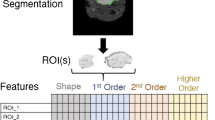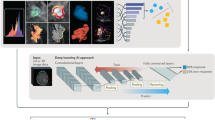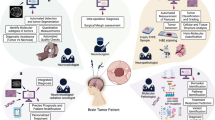Abstract
Machine learning algorithms can help to improve the accuracy and efficiency of cancer diagnosis, selection of personalized therapies and prediction of long-term outcomes. Artificial intelligence (AI) describes a subset of machine learning that can identify patterns in data and take actions to reach pre-set goals without specific programming. Machine learning tools can help to identify high-risk populations, prescribe personalized screening tests and enrich patient populations that are most likely to benefit from advanced imaging tests. AI algorithms can also help to plan personalized therapies and predict the impact of genomic variations on the sensitivity of normal and tumor tissue to chemotherapy or radiation therapy. The two main bottlenecks for successful AI applications in pediatric oncology imaging to date are the needs for large data sets and appropriate computer and memory power. With appropriate data entry and processing power, deep convolutional neural networks (CNNs) can process large amounts of imaging data, clinical data and medical literature in very short periods of time and thereby accelerate literature reviews, correct diagnoses and personalized treatments. This article provides a focused review of emerging AI applications that are relevant for the pediatric oncology imaging community.

Similar content being viewed by others
References
Callaway E, Castelvecchi D, Cyranoski D et al (2017) 2017 in news: the science events that shaped the year. Nature 552:304–307
Fetit AE, Novak J, Rodriguez D et al (2018) Radiomics in paediatric neuro-oncology: a multicentre study on MRI texture analysis. NMR Biomed 31:1–13
Banerjee I, Crawley A, Bhethanabotla M et al (2018) Transfer learning on fused multiparametric MR images for classifying histopathological subtypes of rhabdomyosarcoma. Comput Med Imaging Graph 65:167–175
Grewal M, Srivastava M, Kumar P, Varadarajan S (2017) RADNET: radiologist level accuracy using deep learning for hemorrhage detection in CT scans. https://arxiv.org/abs/1710.04934. Accessed 18 Jan 2019
Huang YH, Feng QJ (2018) Segmentation of brain tumor on magnetic resonance images using 3D full-convolutional densely connected convolutional networks. Nan Fang Yi Ke Da Xue Xue Bao 38:661–668
Erickson BJ, Korfiatis P, Akkus Z et al (2017) Machine learning for medical imaging. Radiographics 37:505–515
Kang J, Rancati T, Lee S et al (2018) Machine learning and radiogenomics: lessons learned and future directions. Front Oncol 8:228
Marshall GM, Carter DR, Cheung BB et al (2014) The prenatal origins of cancer. Nat Rev Cancer 14:277–289
Fortunato O, Boeri M, Verri C et al (2014) Assessment of circulating microRNAs in plasma of lung cancer patients. Molecules 19:3038–3054
Zhang B, Liang XL, Gao HY et al (2016) Models of logistic regression analysis, support vector machine, and back-propagation neural network based on serum tumor markers in colorectal cancer diagnosis. Genet Mol Res 15(2). https://doi.org/10.4238/gmr.15028643
Hornbrook MC, Goshen R, Choman E et al (2017) Early colorectal cancer detected by machine learning model using gender, age, and complete blood count data. Dig Dis Sci 62:2719–2727
Lu L, Sun J, Shi P et al (2017) Identification of circular RNAs as a promising new class of diagnostic biomarkers for human breast cancer. Oncotarget 8:44096–44107
Patterson AD, Maurhofer O, Beyoglu D et al (2011) Aberrant lipid metabolism in hepatocellular carcinoma revealed by plasma metabolomics and lipid profiling. Cancer Res 71:6590–6600
Kumar P, Gill RM, Phelps A et al (2018) Surveillance screening in Li-Fraumeni syndrome: raising awareness of false positives. Cureus 10:e2527
Schooler GR, Davis JT, Daldrup-Link HE et al (2018) Current utilization and procedural practices in pediatric whole-body MRI. Pediatr Radiol 48:1101–1107
Kang E, Min J, Ye JC (2017) A deep convolutional neural network using directional wavelets for low-dose X-ray CT reconstruction. Med Phys 44:e360–e375
Gondara L (2016) Medical image denoising using convolutional denoising autoencoders. 2016 IEEE 16th International Conference on Data Mining Workshops (ICDMW), Barcelona, Spain, pp 241–246
Xu J, Gong E, Pauly JM, Zaharchuk G (2018) 200x low-dose PET reconstruction using deep learning. NIPS Healthcare Workshop 2017. https://arxiv.org/abs/1712.04119. Accessed 18 Jan 2019
Zhu B, Liu JZ, Cauley SF et al (2018) Image reconstruction by domain-transform manifold learning. Nature 555:487–492
Gong E, Pauly JM, Wintermark M et al (2018) Deep learning enables reduced gadolinium dose for contrast-enhanced brain MRI. J Magn Reson Imaging 48:330–340
Larson DB, Chen MC, Lungren MP et al (2018) Performance of a deep-learning neural network model in assessing skeletal maturity on pediatric hand radiographs. Radiology 287:313–322
Rajpurkar P, Irvin J, Zhu K et al (2018) CheXNet: radiologist-level pneumonia detection on chest X-rays with deep learning. IEEE Computer Society Conference on Computer Vision and Pattern Recognition. https://arxiv.org/abs/1711.05225. Accessed 18 Jan 2019
Becker AS, Mueller M, Stoffel E et al (2018) Classification of breast cancer in ultrasound imaging using a generic deep learning analysis software: a pilot study. Br J Radiol 91:20170576
Afifi A, Nakaguchi T (2015) Unsupervised detection of liver lesions in CT images. Conf Proc IEEE Eng Med Biol Soc 2015:2411–2414
Soltaninejad M, Yang G, Lambrou T et al (2017) Automated brain tumour detection and segmentation using superpixel-based extremely randomized trees in FLAIR MRI. Int J Comput Assist Radiol Surg 12:183–203
Bi L, Kim J, Kumar A et al (2017) Automatic detection and classification of regions of FDG uptake in whole-body PET-CT lymphoma studies. Comput Med Imaging Graph 60:3–10
Helm EJ, Silva CT, Roberts HC et al (2009) Computer-aided detection for the identification of pulmonary nodules in pediatric oncology patients: initial experience. Pediatr Radiol 39:685–693
Linguraru MG, Richbourg WJ, Liu J et al (2012) Tumor burden analysis on computed tomography by automated liver and tumor segmentation. IEEE Trans Med Imaging 31:1965–1976
Tu SJ, Wang CW, Pan KT et al (2018) Localized thin-section CT with radiomics feature extraction and machine learning to classify early-detected pulmonary nodules from lung cancer screening. Phys Med Biol 63:065005
Chen S, Harmon S, Perk T et al (2017) Diagnostic classification of solitary pulmonary nodules using dual time (18)F-FDG PET/CT image texture features in granuloma-endemic regions. Sci Rep 7:9370
Perk T, Bradshaw T, Chen S et al (2018) Automated classification of benign and malignant lesions in (18)F-NaF PET/CT images using machine learning. Phys Med Biol 63:225019
Kickingereder P, Bonekamp D, Nowosielski M et al (2016) Radiogenomics of glioblastoma: machine learning-based classification of molecular characteristics by using multiparametric and multiregional MR imaging features. Radiology 281:907–918
Bae S, Choi YS, Ahn SS et al (2018) Radiomic MRI phenotyping of glioblastoma: improving survival prediction. Radiology 289:797–806
Zarinabad N, Wilson M, Gill SK et al (2017) Multiclass imbalance learning: improving classification of pediatric brain tumors from magnetic resonance spectroscopy. Magn Reson Med 77:2114–2124
Hirsch FW, Sattler B, Sorge I et al (2013) PET/MR in children. Initial clinical experience in paediatric oncology using an integrated PET/MR scanner. Pediatr Radiol 43:860–875
Schafer JF, Gatidis S, Schmidt H et al (2014) Simultaneous whole-body PET/MR imaging in comparison to PET/CT in pediatric oncology: initial results. Radiology 273:220–231
Daldrup-Link H, Voss S, Donig J (2014) ACR Committee on pediatric imaging research. Pediatr Radiol 44:1193–1194
Graham MM, Badawi RD, Wahl RL (2011) Variations in PET/CT methodology for oncologic imaging at U.S. academic medical centers: an imaging response assessment team survey. J Nucl Med 52:311–317
Men K, Zhang T, Chen X et al (2018) Fully automatic and robust segmentation of the clinical target volume for radiotherapy of breast cancer using big data and deep learning. Phys Med 50:13–19
Glass JO, Reddick WE (1998) Hybrid artificial neural network segmentation and classification of dynamic contrast-enhanced MR imaging (DEMRI) of osteosarcoma. Magn Reson Imaging 16:1075–1083
Kleis M, Daldrup-Link H, Matthay K et al (2009) Diagnostic value of PET/CT for the staging and restaging of pediatric tumors. Eur J Nucl Med Mol Imaging 36:23–36
McCarville MB (2008) New frontiers in pediatric oncologic imaging. Cancer Imaging 8:87–92
Cairns J, Ung CY, da Rocha EL et al (2016) A network-based phenotype mapping approach to identify genes that modulate drug response phenotypes. Sci Rep 6:37003
Han I, Kim JH, Park H et al (2018) Deep learning approach for survival prediction for patients with synovial sarcoma. Tumour Biol 40. https://doi.org/10.1177/1010428318799264
Cha YJ, Jang WI, Kim MS et al (2018) Prediction of response to stereotactic radiosurgery for brain metastases using convolutional neural networks. Anticancer Res 38:5437–5445
Ibragimov B, Toesca D, Chang D et al (2018) Development of deep neural network for individualized hepatobiliary toxicity prediction after liver SBRT. Med Phys 45:4763–4774
Sun W, Sanderson PE, Zheng W (2016) Drug combination therapy increases successful drug repositioning. Drug Discov Today 21:1189–1195
Salazar BM, Balczewski EA, Ung CY, Zhu S (2016) Neuroblastoma, a paradigm for big data science in pediatric oncology. Int J Mol Sci 18. https://doi.org/10.3390/ijms18010037
Matsuzaki T, Oda M, Kitasaka T et al (2015) Automated anatomical labeling of abdominal arteries and hepatic portal system extracted from abdominal CT volumes. Med Image Anal 20:152–161
Esteva A, Kuprel B, Novoa RA et al (2017) Dermatologist-level classification of skin cancer with deep neural networks. Nature 542:115–118
Ratner AJ, Ehrenberg HR, Hussain Z et al (2017) Learning to compose domain-specific transformations for data augmentation. Adv Neural Inf Process Syst 30:3239–3249
Havaei M, Davy A, Warde-Farley D et al (2017) Brain tumor segmentation with deep neural networks. Med Image Anal 35:18–31
Havaei M, Larochelle H, Poulin P et al (2016) Within-brain classification for brain tumor segmentation. Int J Comput Assist Radiol Surg 11:777–788
Beecy AN, Chang Q, Anchouche K et al (2018) A novel deep learning approach for automated diagnosis of acute ischemic infarction on computed tomography. JACC Cardiovasc Imaging 11:1723–1725
Acknowledgments
This work was supported by a grant from the Eunice Kennedy Shriver National Institute of Child Health and Human Development, grant number R01 HD081123-01A1.
Author information
Authors and Affiliations
Corresponding author
Ethics declarations
Conflicts of interest
None
Additional information
Publisher’s note
Springer Nature remains neutral with regard to jurisdictional claims in published maps and institutional affiliations.
Rights and permissions
About this article
Cite this article
Daldrup-Link, H. Artificial intelligence applications for pediatric oncology imaging. Pediatr Radiol 49, 1384–1390 (2019). https://doi.org/10.1007/s00247-019-04360-1
Received:
Revised:
Accepted:
Published:
Issue Date:
DOI: https://doi.org/10.1007/s00247-019-04360-1




